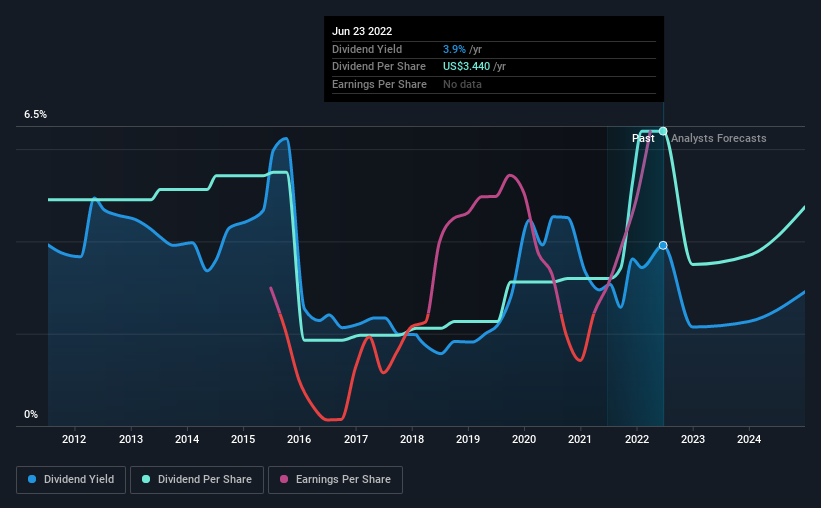Here's What We Like About ConocoPhillips' (NYSE:COP) Upcoming Dividend
ConocoPhillips (NYSE:COP) stock is about to trade ex-dividend in 2 days. The ex-dividend date is one business day before a company's record date, which is the date on which the company determines which shareholders are entitled to receive a dividend. The ex-dividend date is important as the process of settlement involves two full business days. So if you miss that date, you would not show up on the company's books on the record date. Accordingly, ConocoPhillips investors that purchase the stock on or after the 27th of June will not receive the dividend, which will be paid on the 15th of July.
The company's next dividend payment will be US$0.70 per share, and in the last 12 months, the company paid a total of US$3.44 per share. Based on the last year's worth of payments, ConocoPhillips has a trailing yield of 3.9% on the current stock price of $87.89. Dividends are a major contributor to investment returns for long term holders, but only if the dividend continues to be paid. As a result, readers should always check whether ConocoPhillips has been able to grow its dividends, or if the dividend might be cut.
Check out our latest analysis for ConocoPhillips
Dividends are typically paid out of company income, so if a company pays out more than it earned, its dividend is usually at a higher risk of being cut. ConocoPhillips is paying out just 20% of its profit after tax, which is comfortably low and leaves plenty of breathing room in the case of adverse events. A useful secondary check can be to evaluate whether ConocoPhillips generated enough free cash flow to afford its dividend. It paid out 21% of its free cash flow as dividends last year, which is conservatively low.
It's positive to see that ConocoPhillips's dividend is covered by both profits and cash flow, since this is generally a sign that the dividend is sustainable, and a lower payout ratio usually suggests a greater margin of safety before the dividend gets cut.
Click here to see the company's payout ratio, plus analyst estimates of its future dividends.
Have Earnings And Dividends Been Growing?
Businesses with strong growth prospects usually make the best dividend payers, because it's easier to grow dividends when earnings per share are improving. If business enters a downturn and the dividend is cut, the company could see its value fall precipitously. That's why it's comforting to see ConocoPhillips's earnings have been skyrocketing, up 26% per annum for the past five years. With earnings per share growing rapidly and the company sensibly reinvesting almost all of its profits within the business, ConocoPhillips looks like a promising growth company.
Many investors will assess a company's dividend performance by evaluating how much the dividend payments have changed over time. ConocoPhillips has delivered an average of 2.7% per year annual increase in its dividend, based on the past 10 years of dividend payments. Earnings per share have been growing much quicker than dividends, potentially because ConocoPhillips is keeping back more of its profits to grow the business.
Final Takeaway
Is ConocoPhillips worth buying for its dividend? It's great that ConocoPhillips is growing earnings per share while simultaneously paying out a low percentage of both its earnings and cash flow. It's disappointing to see the dividend has been cut at least once in the past, but as things stand now, the low payout ratio suggests a conservative approach to dividends, which we like. It's a promising combination that should mark this company worthy of closer attention.
On that note, you'll want to research what risks ConocoPhillips is facing. We've identified 4 warning signs with ConocoPhillips (at least 1 which is potentially serious), and understanding them should be part of your investment process.
A common investing mistake is buying the first interesting stock you see. Here you can find a full list of high-yield dividend stocks.
Have feedback on this article? Concerned about the content? Get in touch with us directly. Alternatively, email editorial-team (at) simplywallst.com.
This article by Simply Wall St is general in nature. We provide commentary based on historical data and analyst forecasts only using an unbiased methodology and our articles are not intended to be financial advice. It does not constitute a recommendation to buy or sell any stock, and does not take account of your objectives, or your financial situation. We aim to bring you long-term focused analysis driven by fundamental data. Note that our analysis may not factor in the latest price-sensitive company announcements or qualitative material. Simply Wall St has no position in any stocks mentioned.


